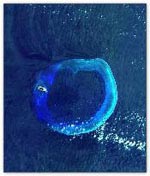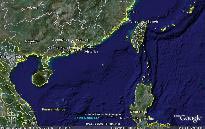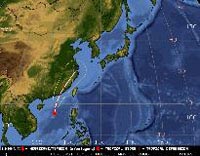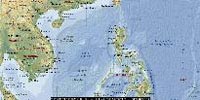 |
|
Dongsha Island photographed from an airplane, where Vietnamese fishing boats took shelter during the storm on May 17, 2006 |
Using Google Earth, we can easily locate the site of the accident involving Vietnamese fishermen during the recent Chanchu storm. By entering the coordinates 20.30N, 116.47E in the search box of Google Earth, the “Earth” spins to that exact point and zooms in until a small island becomes visible, complete with names and related information. This island is known as Dongsha in Vietnam, Dongsha Island in China, and Pratas Island in English. Currently, it is administered by Taiwan, which has a small airport and a meteorological station on the island. In another search, we obtained some beautiful aerial photographs of this island, which resembles a diamond sitting on a coral ring, appearing like a beautiful ring from above.
Some of our fishermen had entered this coral ring to seek shelter from the storm, while others anchored their boats outside.
The waters inside the shore are shallow, with depths under 200 meters, but the sea outside, to the southeast of the island, is very deep, ranging from 200 to 2,000 meters according to topographic maps. At the coordinates 14.00N, 117.00E, about 500 miles east of Quy Nhon city, the depth reaches -4,364 meters. Because of this depth, fishing boats in these waters are equipped with a parachute-like device, a 4-meter square cloth that is deployed into the water to act as a parachute, preventing the boat from drifting when it cannot anchor to the seabed.
 |
|
Dongsha resembles a ring in the center of the photo |
The depth explains why so few bodies were recovered: 21 out of 254 people were found. Firstly, those with life jackets or who tied themselves to plastic barrels or gas tanks were more likely to be retrieved. Typically, if a person dies with their lungs not filled with water, they will float; however, if their lungs are filled with water from inhalation, they will sink. Bodies that sink for three days begin to decompose; bacteria in the intestines produce gas, causing the body to bloat and float for up to seven days. After seven days, the intestines may burst, releasing gas, and the body will remain neutrally buoyant for nine days. This phenomenon is why there is the saying “three days sinking, seven days floating, nine days adrift.”
In deep-sea conditions, however, bodies that sink cannot resurface. When they reach a certain depth, the water pressure compresses the body, flattening the intestines and making them prone to rupturing. The gases produced by decomposition can easily escape, preventing the formation of gas pockets that would cause the body to float.
Time has passed since the tragedy, and the sea has returned to its deep blue color. Yet, through satellite images or aerial photographs available online, we still feel a wave of emotion when we see the site of the disaster on May 17. Our fishermen are truly remarkable for venturing into such distant waters for fishing. The incident will surely serve as a lesson for the relevant authorities, but it is worth noting that some fishermen appear to be targeting areas in the eastern Philippines, which is entirely in the Pacific Ocean and no longer in the South China Sea. There, there are fault lines that create some of the deepest trenches in the world, such as the Mariana Trench, which reaches depths of 11,033 meters, or the Philippine Trench, near the eastern shore of the Philippine archipelago, with depths of up to 10,057 meters. It is said that giant squids measuring up to 2 meters can be found there!
 |
 |
| The center of the Chanchu storm on May 16 | Depth map of the South China Sea |
Trung Ho


















































